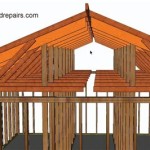What Size Ceiling Fan Should I Get For My Living Room?
Selecting the appropriate size ceiling fan for a living room is a crucial step in ensuring both comfort and energy efficiency within the space. A fan that is too small will fail to circulate air effectively, leaving occupants feeling stagnant and overheated. Conversely, a fan that is excessively large can create an uncomfortable draft and may overwhelm the room's aesthetic. Therefore, carefully considering the dimensions of the living room is essential for making an informed decision.
The primary function of a ceiling fan is to move air, creating a cooling effect through convection and evaporation. By circulating air, a ceiling fan can help to distribute conditioned air more evenly throughout the room, reducing reliance on air conditioning and heating systems. In the summer, a ceiling fan running counter-clockwise will push air downwards, creating a refreshing breeze. In the winter, reversing the fan's direction to clockwise at a low speed will gently pull warm air down from the ceiling, improving heating efficiency. The effectiveness of these functions is directly tied to the size and blade span of the fan.
Numerous factors contribute to determining the ideal ceiling fan size. These factors extend beyond simply the square footage of the room and encompass ceiling height, room usage, and personal preferences. Understanding these considerations is vital for optimizing air circulation and achieving the desired level of comfort.
Understanding Room Size and Blade Span
The most fundamental factor in selecting a ceiling fan is the size of the living room, typically measured in square feet. The blade span of the fan, which is the diameter of the circle the blades create as they rotate, needs to be appropriately sized for the room's dimensions. Several guidelines have been established to assist in matching blade span to room size.
For rooms up to 75 square feet, a ceiling fan with a blade span of 36 inches or less is generally recommended. These smaller fans are suitable for very small living rooms, breakfast nooks, or home offices. They provide adequate air circulation without being overpowering in the space.
In living rooms ranging from 76 to 144 square feet, a ceiling fan with a blade span of 42 inches is often the best choice. This size provides a good balance between air movement and visual appeal for moderately sized rooms. It's a common option for apartments or smaller single-family homes.
For living rooms between 144 and 225 square feet, a 52-inch ceiling fan is widely considered the standard. This size provides ample airflow for most average-sized living rooms and is a popular choice due to its versatility and availability. It strikes a balance between functionality and aesthetics.
Larger living rooms, ranging from 225 to 400 square feet, typically benefit from ceiling fans with blade spans of 56 inches or greater. These larger fans are designed to move a significant amount of air, making them ideal for open-concept living spaces or rooms with high ceilings. Some homeowners may even opt for multiple smaller fans in very large rooms to ensure adequate coverage.
For very large living rooms exceeding 400 square feet, a 60-inch or even a 72-inch ceiling fan may be necessary to achieve optimal air circulation. These extra-large fans are specifically designed for expansive spaces and can effectively cool or heat large areas. Consideration should be given to the room's layout and furniture placement to ensure the fan can operate without obstruction.
It's important to note that these are general guidelines. The specific needs of a living room can vary based on factors such as ceiling height, window placement, and insulation levels. A room with poor insulation, for example, may require a larger fan to compensate for heat loss or gain.
Considering Ceiling Height and Downrod Length
Ceiling height is another critical factor influencing ceiling fan selection. The distance between the floor and the ceiling affects how effectively the fan can circulate air and how safely it can operate. To maximize airflow and ensure safety, it is important to maintain a minimum clearance between the fan blades and the floor.
For standard 8-foot ceilings, a flush-mount or "hugger" style ceiling fan is generally recommended. These fans are designed to sit close to the ceiling, maximizing headroom and preventing any potential safety hazards. Flush-mount fans are a practical choice for rooms with lower ceilings where a downrod would be impractical or even dangerous.
For ceilings between 9 and 10 feet high, a short downrod is usually necessary to position the fan at the optimal height for air circulation. A downrod is a metal extension that connects the fan motor to the mounting bracket, lowering the fan from the ceiling. A 6-inch to 12-inch downrod is typically sufficient for these ceiling heights.
For ceilings taller than 10 feet, longer downrods are required to bring the fan down to a level where it can effectively circulate air throughout the room. A good rule of thumb is to ensure that the fan blades are approximately 8 to 9 feet from the floor. This height allows for optimal air movement without posing a safety risk.
Using an appropriately sized downrod is crucial for both safety and performance. If the fan is too close to the ceiling, it will not be able to circulate air effectively. If the fan is too low, it could pose a hazard to taller individuals or obstruct furniture placement.
The use of an improperly sized downrod can also affect the fan's balance and stability. A downrod that is too long or too short can cause the fan to wobble or vibrate, potentially leading to premature wear and tear or even damage to the ceiling.
Additional Factors to Consider
Beyond room size and ceiling height, other factors can influence the ideal ceiling fan size for a living room. These factors include the room's usage, the number of occupants, and personal preferences regarding airflow and aesthetics.
If the living room is frequently used for activities such as exercising, a larger fan or multiple fans may be necessary to provide adequate cooling. Similarly, if the room is often occupied by a large number of people, increased airflow will help to maintain a comfortable temperature.
The placement of windows and doors can also affect air circulation. A living room with numerous windows or doors may experience drafts or uneven temperature distribution, requiring a fan with a higher airflow rating to compensate.
Personal preferences regarding airflow also play a role in the decision-making process. Some individuals prefer a strong, noticeable breeze, while others prefer a more gentle air circulation. The fan's speed settings and blade pitch can be adjusted to customize the airflow to individual preferences.
The aesthetic of the ceiling fan should also be considered. The fan should complement the overall style of the living room and not appear out of place. Ceiling fans are available in a wide range of styles, finishes, and blade designs to suit various décor preferences.
Finally, energy efficiency should be a key consideration when selecting a ceiling fan. Look for fans with the Energy Star label, which indicates that they meet strict energy efficiency guidelines set by the Environmental Protection Agency (EPA). Energy Star-certified fans can save energy and reduce utility bills.
By carefully considering room size, ceiling height, usage patterns, and personal preferences, homeowners can select the ideal ceiling fan size for their living room, ensuring both comfort and energy efficiency.

Ceiling Fan Size Guide Delmarfans Com

Ceiling Fan Size Guide Delmarfans Com

How To Choose The Best Ceiling Fan

Choosing A Ceiling Fan For The Living Room 5 Principles Not To Be Missed Mr Vu Singapore

Choosing The Right Size Ceiling Fan For Your Space

Use These Ideas To Pick The Best Ceiling Fan For Your House

Ceiling Fan Size Guide Delmarfans Com

Ceiling Fan Size Guide For Every Room 4 Tips Chart Homeyfad

How To Choose A Ceiling Fan Create The Perfect Personalized Cooling Space In Your Home

Ceiling Fan Size Blade Airflow Guide Value Lights Blog
Related Posts








